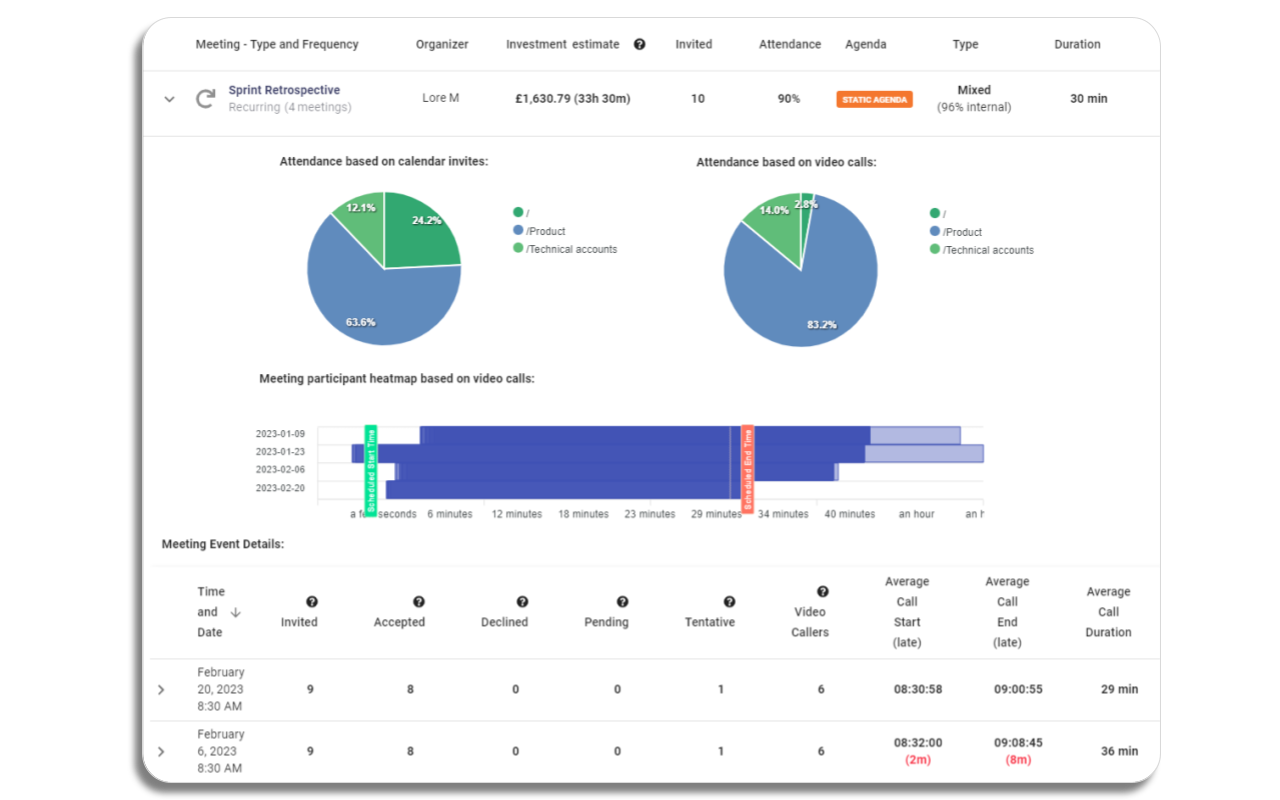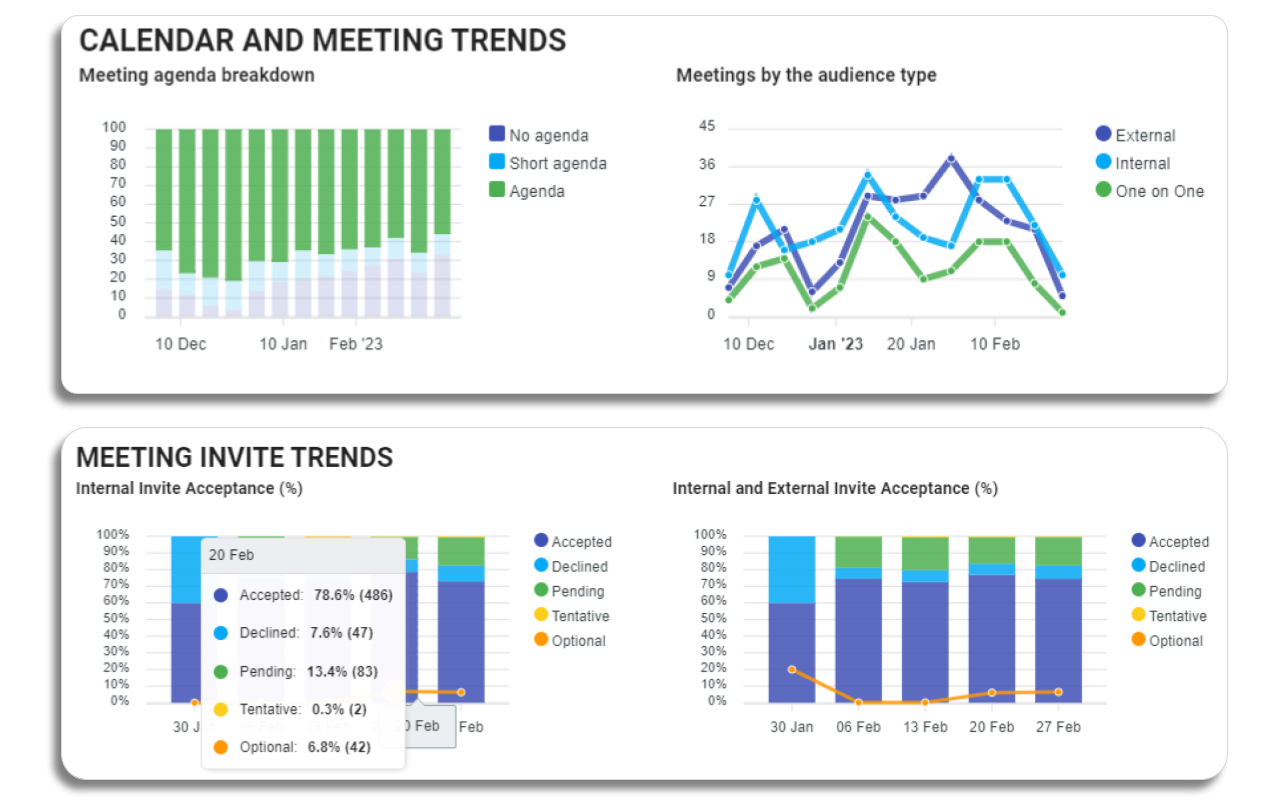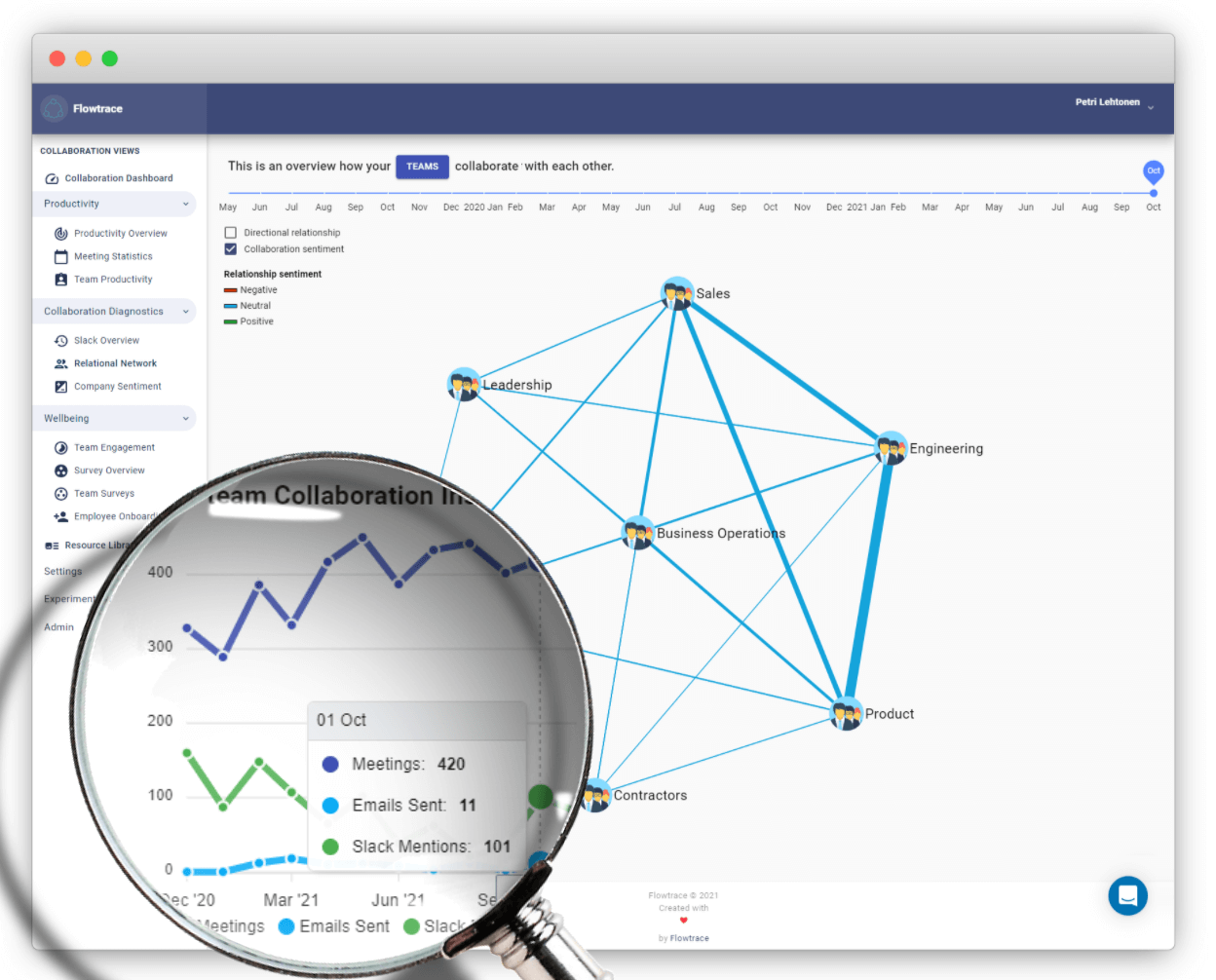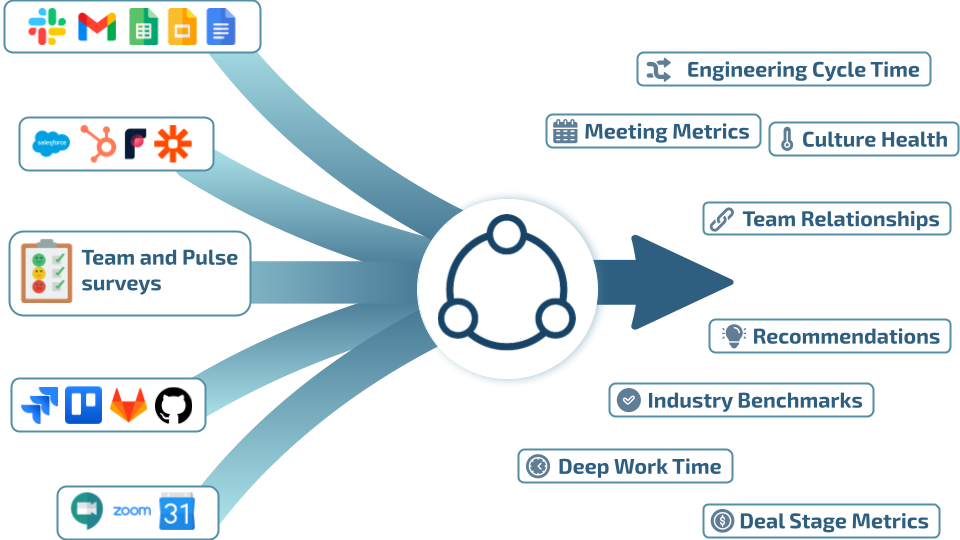Best Collaboration Tools for Remote Teams 2023
Explore the top collaboration tools for remote teams in 2023. Discover their unique features and learn how to choose the right one for your team.
Boost remote team productivity and enhance remote work communication with calendar analytics. Discover how Flowtrace can help.
As remote work continues to be a mainstay in many organizations, the need for effective management of our work schedules has become increasingly important. With our calendars often filled with back-to-back meetings, understanding how we spend our time is crucial for productivity. In this context, calendar analytics has emerged as a powerful tool to provide valuable insights into our work habits.
According to a study by Atlassian, the average employee attends 62 meetings per month, with half of these meetings considered as wasted time. That's a staggering 31 hours spent in unproductive meetings every month! Furthermore, the study found that employees face 56 interruptions a day on average, and spend two hours recovering from these distractions. In a remote work setting, meetings can quickly become a source of fatigue and employee frustration if not managed effectively. The terms "Zoom fatigue" and "meeting overload" have become common in our lexicon, reflecting a widespread struggle.

However, with the right strategies and tools, meetings can transform from a source of stress into a powerful catalyst for collaboration, innovation, and progress in remote work. The key is understanding our meeting habits and making informed decisions about how we conduct them. This is where calendar analytics comes into play.
In this article, we'll delve into the challenges of managing meeting culture in remote teams, discuss strategies to enhance remote work productivity, and explore the role of calendar analytics in this process. Whether you're a team leader, a project manager, or a remote worker navigating your workday, you'll find actionable insights to help you optimize your meetings.
In the remote work environment, effective communication is not just a necessity—it's the lifeblood that keeps the team functioning. It's the bridge that connects team members across geographical boundaries, ensuring everyone is aligned towards common goals.

However, the lack of physical proximity can pose unique challenges. The absence of face-to-face interaction can lead to misunderstandings, as non-verbal cues are harder to pick up. Time zone differences can make scheduling meetings a logistical puzzle. The potential for miscommunication is heightened, and feelings of isolation can creep in, impacting team cohesion and morale.
Moreover, the reliance on digital tools for communication can lead to its own set of issues. Information overload, communication fatigue, and the blurring of boundaries between work and personal life are common problems in the remote work setup.
.webp?width=1629&height=1001&name=magnifyingglassproductivity-2%20(3).webp)
Despite these challenges, effective communication in remote teams is not an insurmountable goal. It requires a conscious effort to adapt traditional communication strategies to the remote context, a willingness to leverage technology, and a commitment to maintaining open and transparent communication channels.
In the next section, we'll explore how calendar analytics can play a pivotal role in enhancing communication and meeting culture in remote teams.
In the world of remote work, calendar analytics has emerged as a powerful tool for improving communication and meeting culture. But what exactly is calendar analytics, and how can it help remote teams?
At its core, calendar analytics is the process of analyzing calendar data to gain insights into how time is spent within an organization. This can include everything from the number and duration of meetings to the participants involved and the topics discussed. By examining this data, organizations can identify patterns and trends that may be impacting their productivity and efficiency.

For remote teams, calendar analytics can be particularly beneficial. With team members often spread across different time zones and working schedules, coordinating meetings and ensuring effective communication can be a challenge. Calendar analytics can help to identify potential issues, such as meeting overload or inefficient scheduling, and provide the data needed to make informed decisions.
For example, if the data shows that a team is spending a large portion of their time in meetings, it may be a sign that they are suffering from meeting overload. This could be addressed by implementing policies to limit the number of meetings or by using tools to make meetings more efficient.
Similarly, if the data shows that certain team members are often left out of important meetings, it could indicate a communication breakdown. In this case, steps could be taken to improve inclusion and ensure that everyone is kept in the loop.

In essence, calendar analytics provides a realtime "calendar audit" and an always up to date view of your current meeting management practices. By understanding how time is being spent, organizations can make changes to improve their communication and meeting culture, ultimately enhancing their overall productivity.
For a more detailed look at how to conduct a calendar audit, you can check out our previous blog post here.
Calendar analytics can be a game-changer for remote work communication. It provides valuable insights that can help you optimize your meeting culture and your team's communication. Here's how you can leverage calendar analytics for better remote work communication:
Identify Meeting Overload: One of the most common complaints in remote work is meeting overload. With calendar analytics, you can identify patterns of meeting overload and take steps to address it. This could involve reducing the number of unnecessary meetings, setting clear agendas to make meetings more efficient, or implementing a policy of no-meeting days to give employees uninterrupted time for deep work.
Optimize Schedules: Calendar analytics can help you understand when your team members are most productive and when they prefer to have meetings. You can use this information to schedule meetings at times that work best for everyone, reducing disruptions and improving productivity.

Set Communication Expectations: With insights from calendar analytics, you can set clear expectations for communication. For example, you might establish guidelines for when to use synchronous vs. asynchronous communication, or set expectations for response times. This can help reduce miscommunication and ensure that everyone is on the same page.
Use Data to Inform Decision-Making: Calendar analytics provides data that can inform your decision-making. For example, if you notice that a particular type of meeting tends to run over time, you might decide to allocate more time for these meetings in the future. Or, if you see that certain team members are consistently overloaded with meetings, you might decide to redistribute some of their responsibilities.

Remember, the goal of using calendar analytics is not to micromanage your team, but to provide them with the support and resources they need to communicate effectively and work productively. By leveraging calendar analytics, you can create a more supportive, efficient, and productive remote work environment.
Flowtrace is a powerful tool designed to enhance remote work communication and meeting culture through the use of calendar analytics. It integrates with your existing collaboration tools, such as Slack, Google Workspace, and Jira, to provide a holistic view of your team's communication and collaboration patterns.

One of the key features of Flowtrace is its ability to analyze your team's calendar data to identify trends and patterns. For instance, it can help you identify if your team is suffering from meeting overload or "Zoom fatigue", common issues in remote work settings. By identifying the number of meetings and their duration, Flowtrace can provide insights into whether your team's time is being used effectively or if there are opportunities for streamlining your meeting culture.

Flowtrace also provides insights into your team's communication patterns. It can show you who communicates with whom, how often, and through what channels. This can help you identify if there are any communication silos within your team or if there are team members who may be feeling isolated.
Moreover, Flowtrace provides actionable recommendations based on the data it analyzes. For instance, it can suggest optimal times for scheduling meetings based on when your team members are most productive. It can also recommend strategies for improving communication, such as encouraging more cross-functional collaboration or reducing the reliance on synchronous communication.
In essence, Flowtrace serves as a valuable ally in your quest to improve remote work communication and meeting culture. It provides the data and insights you need to make informed decisions and implement effective strategies, ultimately leading to a more productive and cohesive remote team.
In the next section, we'll wrap up our discussion and recap the key points we've covered in this article.
As remote work continues to be a significant part of our professional lives, the importance of effective communication and a healthy meeting culture cannot be overstated. The challenges that come with coordinating a remote team—time zone differences, lack of face-to-face interaction, and potential for miscommunication—can be mitigated with the right strategies and tools.
Calendar analytics emerges as a powerful solution in this context, offering insights into team communication patterns, meeting habits, and overall time management. By leveraging these insights, teams can identify areas of improvement, optimize their schedules, and enhance their productivity.

Flowtrace stands as a robust tool in this domain, integrating with your existing collaboration platforms to provide a comprehensive view of your team's communication and collaboration patterns. From identifying meeting overload to suggesting optimal times for scheduling meetings, Flowtrace offers actionable recommendations that can significantly improve your remote work communication and meeting culture.
In the end, the goal is to create a remote work environment where communication is seamless, meetings are productive, and every team member feels connected and engaged. With the right approach and the right tools, this goal is well within reach.
If you're ready to explore how Flowtrace can help your remote team communicate more effectively and foster a healthier meeting culture, we invite you to try our platform. Discover the power of calendar analytics and take a step towards a more productive remote work experience.
Explore the top collaboration tools for remote teams in 2023. Discover their unique features and learn how to choose the right one for your team.
Data-driven insights are key to success in remote teams, improving collaboration, productivity and engagement leading to better outcomes for the team.
Combat Zoom fatigue with Flowtrace's meeting analytics. Optimize virtual meetings, enhance productivity, and improve your remote work experience.